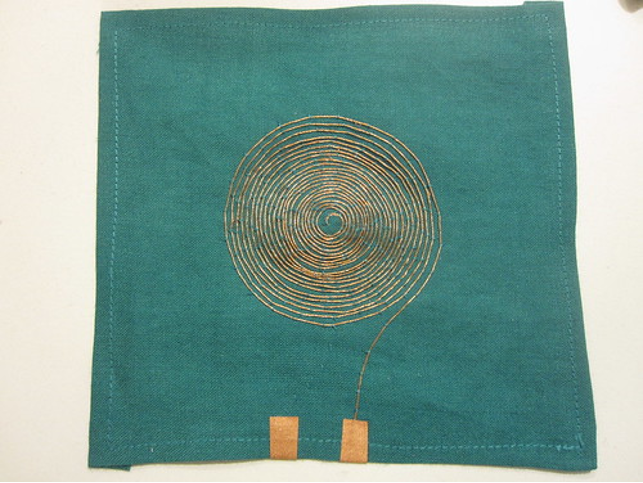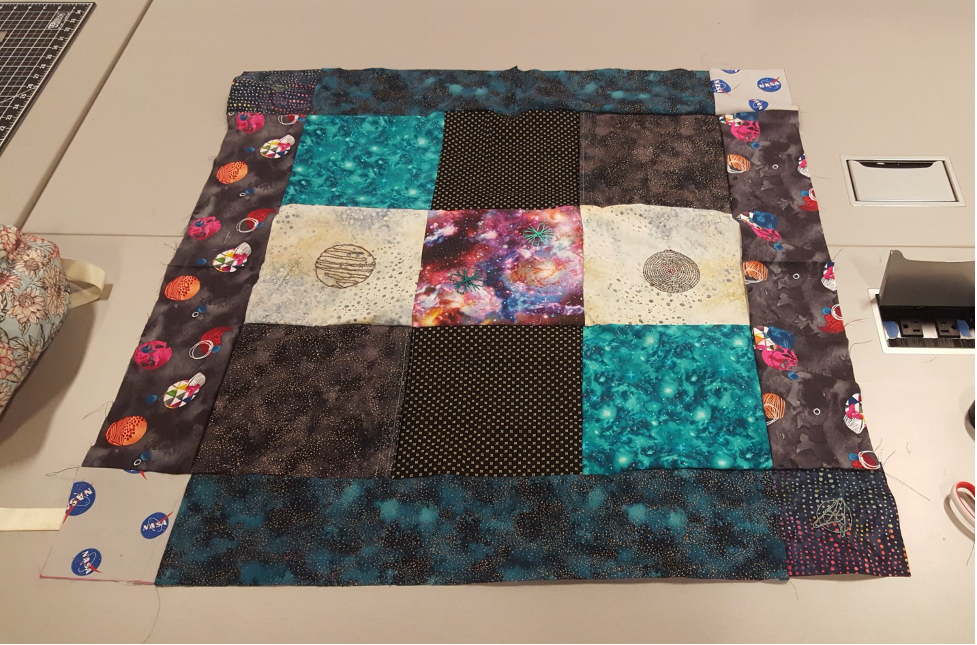By Elizabeth Fuchs, Spring 2019
When I first began conceptualizing this project, I struggled with the question of is this idea in fact critical making? Matt Ratto positions critical making at the intersection of critical thought and physical making with more emphasis towards the process rather than the final object (Ratto pars. 9-11) and yet I found myself focusing on the final object with this constant uncertainty. Was what I was making critical enough? It was only in the creation of the object—the process of making—that I truly began to understand the critical making through the lens of material, technology, choice, change, collaboration, and reflection, many of which have no bearing on the end product but on the path used to get there.
I started by asking myself two questions: what materials and technologies did I want to explore and what problem or issue did I want my project to interact with. Knowing I wanted to work with a combination of fabric and sound, I set about researching different technologies integrating the two. During my research, I came across Kobakant DIY, a website founded by Mika Satomi and Hannah Perner-Wilson that documents and makes accessible their research into wearable technology.
When I saw their technique for embroidering conductive threat onto the surface of a piece of fabric in order to convert it into a speaker (fig. 1) using a magnet to interact with the magnetic field created by the coiling, the process immediately intrigued me.
I saw the interactive possibilities and instantly thought of my nephew. With a combination of Receptive Language Disorder, Expressive Language Disorder, ADHD, he has difficulty understanding and using spoken language. This often leads to moments of frustration over his inability to property articulate his ideas. I devised a pillow that he could use to focus his attention by combining different strategies his therapists as well as my sister had created such as listening to music, relaxing in his bed to reduce extraneous stimuli, as well as interacting with different tactile sensations or fidget-like toys.
However, as I began experiment with the materials and technologies and as speaker coil after speaker coil failed, my ideas and concepts started to change and through the lens of critical making, I realized that that was perfectly acceptable. I began to move away from the idea of the object and started looking more at the materials and process, at how they could interact with a public on a larger scale, and how it could foster an environment as collaborative as I felt in the maker space of the class. In the end, the project morphed from a pillow for my nephew into a participatory, collaborative music-sharing quilt (fig. 2).
In the end, I created Musical Quilts. Musical Quilts is a thirty-three inch square quilt that has two independent sound systems interconnected into the fabric (fig. 3). Underneath the quilt top, an amplifier that can connect to a person’s phone via Bluetooth and a rechargeable battery (A/B) are connected to a speaker (S) located in the center of the quilt. The other wire from the amplifier and battery terminates in a large coil of conductive thread stitched to the surface of the adjoining square, breaking the circuit between the amplifier/battery unit and the speaker. In the corner of the quilt, a smaller coil of conductive thread is connected to the other side of the speaker. When a phone is paired with one of the systems and is playing music, the ‘player’ in this instance, folds the quilt to connect the smaller coil to the larger coil. This completes the circuit and allows the music to play. The player can control the volume of the music in three different ways: with their phone, with the amplifier unit, and most interestingly by the amount of contact between the two different coils that complete the circuit.
Musical Quilts reimagines how we interact with music in public spaces as well as with each other be reintroducing the participatory aspect of music. I enjoy sharing music with my friends and family. My sister and I can spend hours trading songs back and forth as we reminisce about our old favorites but that this takes place in private spaces.
In public spaces, there are boundaries that most people do not cross when it comes to playing music or making loud, attention-drawing sound. In order to maintain the collective quiet, we use headphones or lower the volume on our devices so as not disturb anyone around us. People that do engage in playing music loudly in public are viewed a rude and disrespectful by a majority of the public. Just search online and you will find thread post after thread post about people’s frustrations with those who play loud music in public.
According to Dr. Harry Witchel, this behavior can be attributed to the desire to claim territory. Humans, he argues, treat territory as more of a social construct than a physical one and that social territory is defined by who is ‘in’ and that, “being ‘in’ often manifests itself in displays of social connections: songs, fashion items, beliefs, and even hairstyles” (Witchel 6). Individuals use music to claim and defend space but this is typically a solitary pursuit.
Musical Quilts reconnects music with social connection. By incorporating two different music systems, the quilt encourages interaction and participation. It is no longer about taking space but about sharing and collaborating. The quilt allows for the back and forth dialogue between two people through the music they share that mimics the social interaction with my sister I described earlier. Because the two sound systems are independent of each other, this functions as a mixer, which allows for two pieces of music to be play simultaneously creating one piece. This interaction reflects the collaborative aspects of music.
Furthermore, the materiality of this project as well as critical making in general cannot be ignored. Marshall McLuhan coined the phrase “the medium is the message” in his book Understanding Media: The Extensions of Man, which posits that the medium or technology of an objects is just as important and worth investigation as the content (McLuhan) and for me, critical making epitomizes this notion. Because critical making is so heavily invested in physical doing and making using technologies both material and digital, we must ask ourselves why we chose the materials and technologies we do.
In this instance, why a quilt made of fabric? What does a quilt afford that other technologies do not? I could have just as easily constructed a frame of wood or plastic and each of those choices would have conveyed something different.
In the most technical sense, a quilt is a durable and flexible field that delicate wires and electronics can attach too for stability. A quilt can easily allow for an increase in scale. This project only features two different sound systems but I can imagine future iterations not constrained by time or cost to be much larger consisting of four or even ten systems.
Affectively, one doesn’t expect a quilt to play music. The interactive and unexpected nature of the project allows a playful attitude to imbue the experience in contrast to the assumed inconsiderate and rude motivations of the individual blasting their music in public. The quilt adds softness to the interaction. Blankets and by extension quilts, are objects of warmth and safety connected to the home.
On reflection, even as my project strayed away from its original conception, I find that the end result still speaks to that initial idea. Instead of creating a fidgety, musical pillow for my nephew to wrap his arms around, it’s a quilt that he can instead wrap himself in which functions in many of the same ways but can yield itself to larger ideas.
Works Cited
McLuhan, Marshall. Understanding Media: The Extensions of Man. McGraw-Hill, 1964.
Ratto, Matt. “Critical Making: Conceptual and Material Studies in Technology and Social Life.” The Information Society 27.4 (2011): 252–260. Web.
Satomi, Mika, and Hanna Perner-Wilson. “Fabric Speakers Swatch Examples.” How To Get What You Want, https://www.kobakant.at/DIY/.
Witchel, Harry. You Are What You Hear: How Music and Territory Make Us Who We Are. Algora, 2010.



